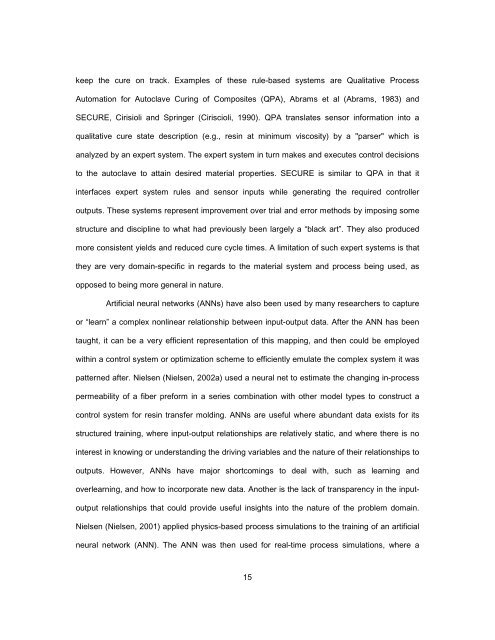TOOLED THICK COMPOSITES by ARVEN H. SAUNDERS III ...
TOOLED THICK COMPOSITES by ARVEN H. SAUNDERS III ...
TOOLED THICK COMPOSITES by ARVEN H. SAUNDERS III ...
You also want an ePaper? Increase the reach of your titles
YUMPU automatically turns print PDFs into web optimized ePapers that Google loves.
keep the cure on track. Examples of these rule-based systems are Qualitative Process<br />
Automation for Autoclave Curing of Composites (QPA), Abrams et al (Abrams, 1983) and<br />
SECURE, Cirisioli and Springer (Ciriscioli, 1990). QPA translates sensor information into a<br />
qualitative cure state description (e.g., resin at minimum viscosity) <strong>by</strong> a "parser" which is<br />
analyzed <strong>by</strong> an expert system. The expert system in turn makes and executes control decisions<br />
to the autoclave to attain desired material properties. SECURE is similar to QPA in that it<br />
interfaces expert system rules and sensor inputs while generating the required controller<br />
outputs. These systems represent improvement over trial and error methods <strong>by</strong> imposing some<br />
structure and discipline to what had previously been largely a “black art”. They also produced<br />
more consistent yields and reduced cure cycle times. A limitation of such expert systems is that<br />
they are very domain-specific in regards to the material system and process being used, as<br />
opposed to being more general in nature.<br />
Artificial neural networks (ANNs) have also been used <strong>by</strong> many researchers to capture<br />
or “learn” a complex nonlinear relationship between input-output data. After the ANN has been<br />
taught, it can be a very efficient representation of this mapping, and then could be employed<br />
within a control system or optimization scheme to efficiently emulate the complex system it was<br />
patterned after. Nielsen (Nielsen, 2002a) used a neural net to estimate the changing in-process<br />
permeability of a fiber preform in a series combination with other model types to construct a<br />
control system for resin transfer molding. ANNs are useful where abundant data exists for its<br />
structured training, where input-output relationships are relatively static, and where there is no<br />
interest in knowing or understanding the driving variables and the nature of their relationships to<br />
outputs. However, ANNs have major shortcomings to deal with, such as learning and<br />
overlearning, and how to incorporate new data. Another is the lack of transparency in the input-<br />
output relationships that could provide useful insights into the nature of the problem domain.<br />
Nielsen (Nielsen, 2001) applied physics-based process simulations to the training of an artificial<br />
neural network (ANN). The ANN was then used for real-time process simulations, where a<br />
15
















